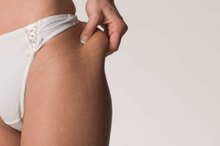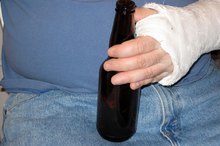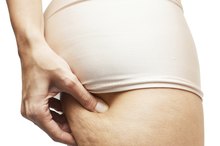How to Reduce Waist Size in Men
Men with a waist size larger than 40 inches are at an increased risk of developing heart disease, stroke, cancer and type 2 diabetes, notes MayoClinic.com. Belly fat, called visceral fat, is more inflammatory than the subcutaneous fat found just under the skin and it encases the internal organs. When men lose weight, the belly usually shrinks naturally. With proper diet and exercise techniques you can effectively drop pounds, and thus reduce your waist size.
Basics of Weight Loss
For most people, weight gain is a result of consuming too many calories. Unless you have a genetic predisposition or medical condition that causes you to retain weight, you lose weight by consuming fewer calories than you burn daily. One pound of weight is equivalent to 3,500 calories. Create a deficit of 500 to 1,000 calories per day through a reduced-calorie diet and increased activity to lose 1 to 2 pounds in a month. The Centers for Disease Control and Prevention recommends sticking to this rate of weight loss because it does not require drastic measures and is most sustainable in the long run. As your weight drops, your waist size will naturally reduce.
Exercise
How to Reduce Excess Fat on Hip & Thighs Fast
Learn More
A study in the “Journal of Applied Physiology” published in October 2005 found that overweight men and women who jogged 20 miles per week were able to lose significant amounts of visceral and subcutaneous abdominal fat after 6 months. This aligns with the American College of Sports Medicine’s recommendations that state you need 250 minutes or more of moderate-intensity cardiovascular exercise per week for clinically significant weight loss. Brisk walking, swimming or cycling are other options for moderate-intensity exercise. The ACSM also recommends you strength train at least two times per week on nonconsecutive days with a routine that addresses every large muscle group -- back, chest, legs, abs and arms -- in one or more sets of eight to 12 repetitions of each exercise. Strength training helps you build lean muscle mass which burns more calories at rest than fat tissue. Start with weight that is challenging to perform for 12 repetitions with proper form.
As you become stronger and more capable of cardio exercise, you may add more weight in 5 to 10 percent increments and participate in some vigorous-intensity exercise, such as running. Change your cardio and strength-training routine every four to six weeks to avoid hitting plateaus that discourage weight loss. Changes may involve altering the exercises you do, increasing intensity or simply re-ordering your exercise schedule to keep your body guessing.
Diet and Nutrition
Reducing portion sizes and limiting your intake of processed foods – such as white bread, sugary cereals, prepackaged meals and fast food – and fatty meats can help you lose weight. Focus on whole foods, including fresh vegetables, lean proteins, unsaturated fats and whole grains. Examples of waist-whittling foods include skinless chicken, brown rice, broccoli, olive oil, nuts, salmon, dark leafy greens and quinoa. Drink water or unsweetened tea at most meals and cut back on the beer. Beer, along with other alcoholic drinks, adds calories to your diet which can impede weight loss. If you decide to drink, stick to just one serving and go for lower-calorie options like wine or a shot of hard liquor mixed with no-calorie soda. Consume at least 10 percent of your calories from protein, the minimum recommended by the Institutes of Medicine. An extremely high-protein diet is not necessary, however, to help you lose weight as found in a study published in the “New England Journal of Medicine” in February 2009. This study compared diets with varying ratios of carbohydrates, fat and protein and found that no matter what the ratio, as long as the diet was low in calories it could induce weight loss. Although you may be focused on your waist-reduction diet plan, remember to allow yourself an occasional indulgence so you do not burn out and stop watching your food intake altogether.
Lifestyle
Can You Get Rid of Cellulite With Diet & Exercise?
Learn More
Quitting tobacco usage can assist your efforts to shrink your midsection. A study in the August 2005 issue of “Circulation” found that teenagers exposed to tobacco smoke had a greater propensity to develop belly fat. In a 2008 issue of the “American Journal of Clinical Nutrition,” a review of the available literature found an association between smoking and a fat abdomen. Chronic lack of sleep is another lifestyle factor that can cause you to overeat and make poor dietary choices. It may also alter the levels of certain hormones in your body that affect metabolism and hunger – leading to weight gain. Stress affects your hormone levels as well and may cause you to overeat. Participate in relaxation techniques such as meditation and yoga to help you sleep better and reduce stress levels.
Related Articles
References
- Centers for Disease Control and Prevetion: Losing Weight
- American College of Sports Medicine: http://www.acsm.org/about-acsm/media-room/news-releases/2011/08/01/acsm-issues-new-recommendations-on-quantity-and-quality-of-exercise
- National Heart Lung and Blood Institute: What are Overweight and Obesity?
- MayoClinic.com: Belly Fat in Men
- New England Journal of Medicine: Comparison of Weight-Loss Diets with Different Compositions of Fat, Protein, and Carbohydrates
- Circulation: Tobacco Smoke Exposure Is Associated With the Metabolic Syndrome in Adolescents
- American Journal of Clinical Nutrition: Consequences of Smoking for Body Weight, Body Fat Distribution, and Insulin Resistance
- Insititute of Medicine: Dietary Reference Intakes for Energy, Carbohydrate, Fiber, Fat, Fatty Acids, Cholesterol, Protein, and Amino Acids
- Journal of Applied Physiology: Inactivity, Exercise and Visceral Fat. STRRIDE: A Randomized, Controlled Study of Exercise Intensity and Amount
- American College of Sports Medicine: ACSM Position Stand on Physical Activity and Weight Loss Now Available
Writer Bio
Andrea Cespedes is a professionally trained chef who has focused studies in nutrition. With more than 20 years of experience in the fitness industry, she coaches cycling and running and teaches Pilates and yoga. She is an American Council on Exercise-certified personal trainer, RYT-200 and has degrees from Princeton and Columbia University.









